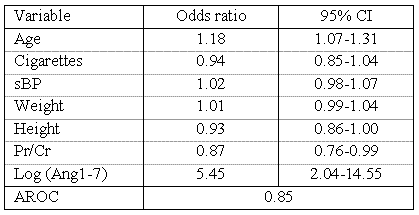306. PREDICTING GESTATIONAL DIABETES FROM MATERNAL ANGIOTENSIN II AND ANGIOTENSIN 1–7 LEVELS AT 15 WEEKS GESTATION
S. D. Sykes A , E. R. Lumbers A , K. G. Pringle A , T. Zakar A , G. A. Dekker B C and C. T. Roberts CA Endocrinology, Mothers and Babies Research Centre, Hunter Medical Research Institute, John Hunt, New Lambton, Australia.
B Lyell McEwin Hospital, Adelaide, SA, Australia.
C Robinson Institute, University of Adelaide, Adelaide, SA, Australia.
Reproduction, Fertility and Development 22(9) 106-106 https://doi.org/10.1071/SRB10Abs306
Published: 6 September 2010
Abstract
Gestational diabetes (GD), a pregnancy complication defined by glucose intolerance with onset during pregnancy, is a condition affecting 5.5%–8.8% of Australian pregnancies1. Untreated GD increases perinatal mortality and babies from GD pregnancies have an increased risk of diabetes and obesity, whilst mothers have an increased risk of type II diabetes later in life1. Circulating levels of angiotensin 1–7 (Ang1–7), a peptide of the renin angiotensin system, have been reported to be reduced in third trimester pregnancies with GD2. The effects of Ang1–7 generally oppose those of angiotensin II (AngII) and it is possible that in early gestation pro-angiogenic functions of AngII are counterbalanced by Ang1–7, causing placental insufficiency and pregnancy complications. We wanted to determine the predictive capability of AngII and Ang1–7, in early gestation, for GD. Healthy nulliparous pregnant women from the Adelaide SCOPE cohort with GD (n = 36) or serving as controls (n = 131) had both peptides measured at 15 weeks using an RIA (D. Casley, Prosearch Pty. Ltd.) on EDTA treated plasma. A predictive model was constructed using logistic regression and area under the curve after ROC analysis (AROC, Table 1). AngII did not change the model and was omitted. This model shows that for every one unit increase of Log (Ang1–7 pg/mL) peptide levels the odds of acquiring GD increase five times, suggesting that Ang1–7 levels in early gestation may be a better disease marker than those seen at late pregnancy.
(1) Hoffman L, Nolan C, Wilson JD, et al., 1998. Gestational diabetes mellitus – management guidelines. The Australasian Diabetes in Pregnancy Society. Med. J. Aust. 169, 93–97.
(2) Nogueira AI, Santos RAS, Simoes e Silva AC, et al., 2007. The pregnancy-induced increase of plasma angiotensin-(1–7) is blunted in gestational diabetes. Regul. Pep., 141, 55–60.

|


